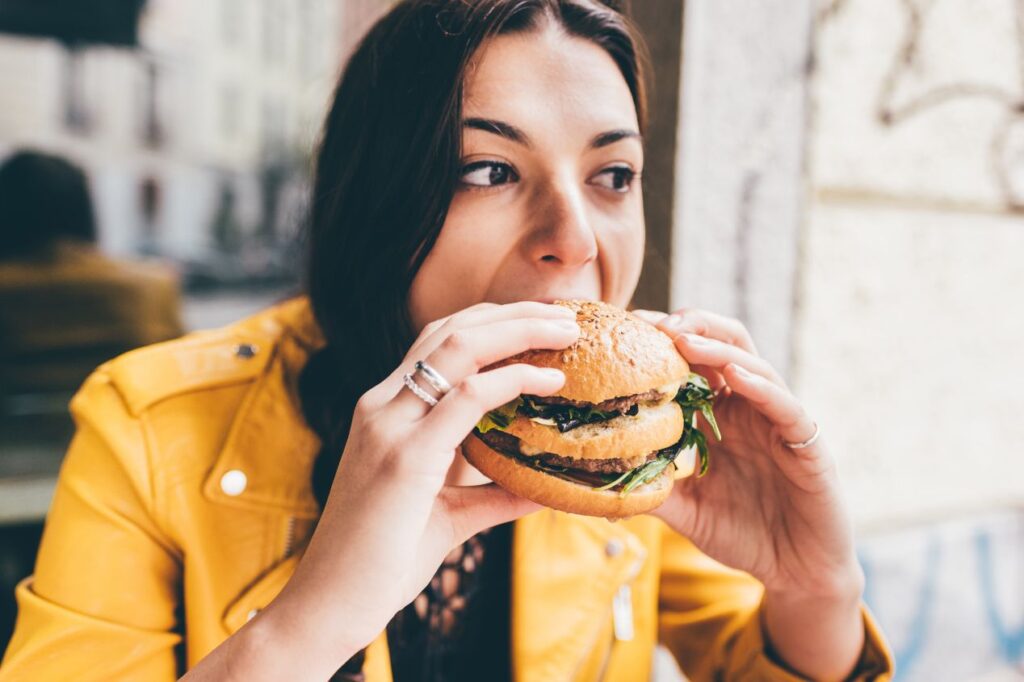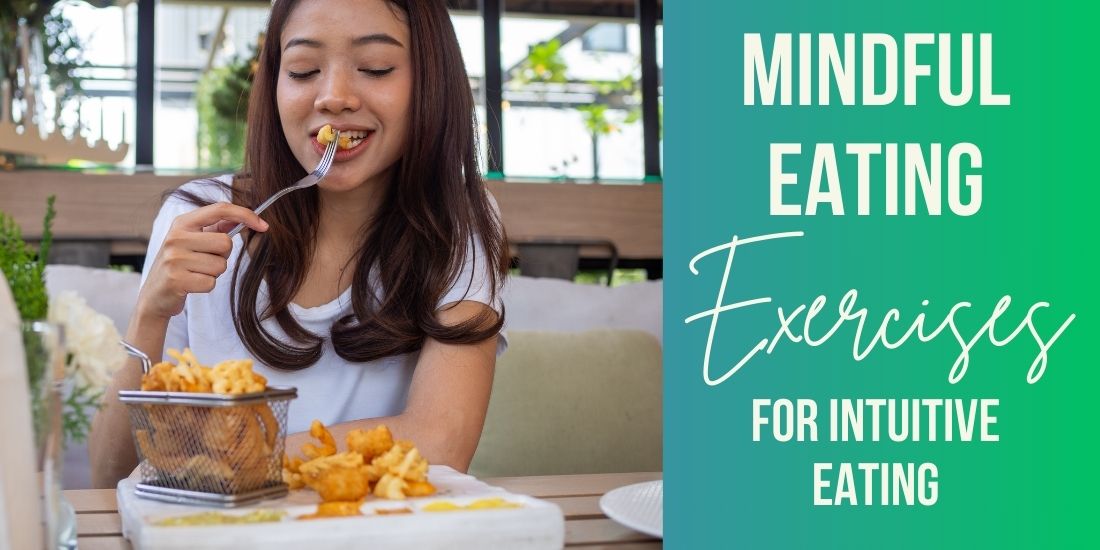Do you eat lunch while checking your emails? Frequently munch on popcorn while you watch TV? Are you regularly eating and scrolling on social media? We are busy and constantly multi-tasking. Today I’m giving you some mindful eating exercises so you can be fully in tune with your body’s fullness cues.
It makes sense. When you are able to focus on your body’s cues, you will stop when you are full. But we’ve all had those moments where we look down at the empty bowl or bag of popcorn and find we ate the whole thing without even realizing it.
Mindful eating is eating without distractions so that you are fully aware of what you are doing. You are present for the full experience. There are many benefits to mindful eating, but it is one of the hardest things to do.
Why is mindful eating so hard? After years of eating while being entertained, it’s difficult to just sit and eat. But I promise you that you’ll get used to it.
If you’re new here, welcome! I’m Erin. I’m an anti-diet dietitian who helps people heal their relationships with food and properly fuel their bodies. My clients manage their health conditions—like PCOS, diabetes, insulin resistance, and more, WITHOUT dieting. I want you to feel good about eating and enjoy ALL of your favorite foods
Today, I’m focusing on how you are eating. I’ll talk about what mindful eating looks like and how it compares to intuitive eating. And I’ll also share some mindful eating exercises so you can get started right away.
Let’s jump in!

What is mindful eating?
Mindful eating is eating food while paying full attention to the food you are consuming. You don’t have the TV on. There’s no email. No Instagram or Facebook. Just you and the food.
You eat your food without judgment, allowing you to enjoy the flavors and textures. There are no food rules or restrictions. You eat what you want, in whatever quantity you’d like. As a result, you are in tune with all senses—smell, appearance, taste, sound, and feel.
As you might guess, because you are experiencing your food to the fullest degree, you end up satisfied. Imagine allowing yourself to eat whatever you want. And you can eat as much of it as you want.
No more TV-food association

If you’re trying to adopt mindful eating strategies, I recommend that you eat in the kitchen. No distractions. If you’re anything like me, it’s pretty contrary to how you’ve eaten your whole life. I grew up enjoying my dessert while watching Supermarket Sweep and Golden Girls. All of my nighttime snacks were in front of the TV. They are some of my fondest and most comforting memories.

However, I didn’t get a chance to fully enjoy my cookies, chips, pretzels, or whatever I was eating. I scarfed them down without even paying attention. Mindful eating does away with that.
Benefits of mindful eating

Have you ever dieted? Many people give up the foods they love while dieting. You have a long list of forbidden foods that have too many calories or too much sugar. You deny yourself your favorite foods. Restrict, restrict, restrict. Then BOOM! You have a moment of weakness and you eat the WHOLE pan of brownies, carton of ice cream, or bag of chips.
Biologically speaking, we don’t do well with dieting. Diets work short term. We see it all of the time on social media. People have great success with keto, low-carb, Weight Watchers, macros, etc. If you do follow up after 6 months, almost everyone gains it back. Or have absolutely wrecked their relationship with food.
Why? Our bodies are great at maintaining our biological set-point weight. It’s that weight you sit at when you aren’t dieting. Your happy weight. The weight you have been at for months and it doesn’t require any effort to stay there.
You can change your set-point weight with extreme measures, like weight loss surgery. But that is rarely (almost NEVER) my recommendation to improve your health.
So what’s a person to do instead? I’m a fan of intuitive and mindful eating. Mindful eating has multiple benefits.
Reasons to try mindful eating
- Improve relationship with food: The mindful eating approach is non-judgemental. You eat any food. And you enjoy it.
- Prevent diabetes: It’s possible to eat as many carbs as you want, but still be able to prevent diabetes. Sound too good to be true? Here’s the thing. If you are eating what you want, but eating mindfully, you will rarely overeat. You’re in touch with your true hunger and fullness. On the other hand, when you restrict and binge, think of the roller coaster your blood sugars are on.
- Greater satisfaction: This one is obvious, right? Think of your last diet. Were you satisfied? The last diet I did was Whole 30. I can assure you, I was not satisfied. Not in the least.
- Reduce disordered eating: Mindful eating interventions have been shown to be useful in treating disordered eating, particularly binge eating.
- Reconnect hunger and fullness cues: If you have struggled with disordered eating or have dieted for years, you may not be able to feel your hunger and fullness. Mindful eating can help you tune in to those cues to help your body naturally regulate your food intake.
- Disconnecting food from feelings: When you eat mindfully you are in tune with WHY you are eating, you are better able to stop eating emotionally. The act of mindful eating trains you to be able to just sit. That’s the hard part about difficult emotions. We eat because we don’t want to sit with our feelings.
I also wanted to mention weight loss. There is a lot of research showing that mindful eating is beneficial for those trying to lose weight. However, this is not a reason I’d recommend someone start eating mindfully. While mindful eating interventions aren’t motivated by weight loss, weight loss often occurs due to the reduction of distracted eating.
Mindful eating vs. intuitive eating
Many people wonder what is the difference between mindful eating and intuitive eating. They really go hand-in-hand. But they are a bit different. Mindful eating is attentive eating. It’s about HOW you eat. It’s about the experience. You are taking your time. It’s learning to focus on how that food interacts with your senses. Intuitive eating, on the other hand, focuses on more than eating.
I’ve discussed the principles of intuitive eating in greater detail, but overall, you are working on your mindset, your eating habits, your movement, and acceptance of your body.
Mindful eating helps with intuitive eating. You have to learn how to eat according to your body’s cues. We mess that up by dieting. Fortunately, mindful eating helps us get in touch again.

Mindful eating exercises
I’m going to warn you. This will feel bizarre at first. I still have the temptation to pick up my phone while I eat. It is hard to just focus on eating. But you get used to it. And it sure is nice to enjoy your food.
Most of my clients (and on occasion, myself) eat with some sort of distraction. So this is one of the first things we’ll work on. Here are some tips for getting started.
- Pick your absolute favorite food. I’m going to pretend you chose ice cream, but you can choose anything.
- Select your bowl, whatever size you want.
- Place however much ice cream you want into the bowl. This is totally up to you. You’re not looking at the nutrition label for the “appropriate” serving size, but giving yourself what you think you’ll eat. I usually start small with the full permission to give myself more.
- Next, you’re going to sit down at the kitchen or dining room table. Not the living room, not your bed, but the kitchen. When you are at home, no food gets eaten anywhere outside the kitchen or dining room.
- Now smell the ice cream. Does it have a strong smell? Is it how you remember?
- Now you’re going to try your first bite. Hold it in your mouth. Let it melt as you enjoy the flavor on your tongue. Don’t rush this part. You are observing the taste, the feel, the temperature.
- Place your spoon down between bites. You don’t want to be focusing on gathering up the next bite yet.
- Take another bite and repeat the process. After a few bites, check-in. Are you still hungry? Is it still tasting good? Are you wanting more or could you be content to stop?
- If you want more, eat more. No judgment. Keep on enjoying your ice cream.
- Do another evaluation. You basically repeat this process until you are satisfied. Not when the bowl is empty, but when you actually want to stop.
Please note that It’s okay to take another scoop if you need it. And it’s also okay to not finish what’s in your bowl. Think of this as a learning assignment, not a reason to feel guilty.
It’s going to take more than once. This is something you’ll have to practice, over and over again. There’s a reason why I call intuitive eating a journey. We have to unlearn a lot of misinformation and habits to change the way we feel about food.
Do you feel like you could use more help in this area? You are not alone. I want you to know that I’m here to help if you need support. I can walk with you on your intuitive eating journey, assisting you in healing your relationship with food. You deserve to be able to enjoy your food.
About the author
Erin is a registered dietitian and diabetes educator with almost 20 years of experience. She specializes in weight-inclusive diabetes care and prevention, intuitive eating, fitness, and women’s health. She works as a consultant and writer in the health and wellness space. Erin is passionate about empowering people to manage their own health and to have peace with food.


